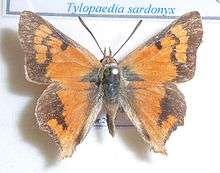Tylopaedia
Tylopaedia is a butterfly genus in the family Lycaenidae.[1] It is monotypic containing only the species Tylopaedia sardonyx, the king copper, which is found in South Africa and Namibia.
| King copper | |
|---|---|
 | |
| Scientific classification | |
| Kingdom: | Animalia |
| Phylum: | Arthropoda |
| Class: | Insecta |
| Order: | Lepidoptera |
| Family: | Lycaenidae |
| Subfamily: | Aphnaeinae |
| Genus: | Tylopaedia Tite & Dickson, 1973 |
| Species: | T. sardonyx |
| Binomial name | |
| Tylopaedia sardonyx (Trimen, 1868) | |
| Synonyms | |
| |
The wingspan is 32–40 mm for males and 35–50 mm females. Adults are on wing from August to December and from January to April in two generations per year.[2]
The larvae feed on Aspalathus spinosa, Phylica olaefolia, and Euclea undulata.
Subspecies
- Tylopaedia sardonyx sardonyx (eastern Western Cape to Namaqualand and near Karuman in the Northern Cape, north into Botswana, east to the Eastern Cape and the Free State)
- Tylopaedia sardonyx peringueyi (Dickson, 1969) (Western Cape)
- Tylopaedia sardonyx cerita Henning & Henning, 1998 (central Namibia)
gollark: Just hook up a really advanced medical AI to a hologram projector thing and let it... I don't know, maybe have a human projection available when it needs to look human to be comforting or whatever, but it can also just arbitrarily generate medical stuff as necessary.
gollark: So why have an emergency medical *humanoid* thing, I mean?
gollark: As an added bonus, they're sterile.
gollark: Oh, and why have a holographic doctor thing anyway except possibly for making patients feel better? Just holographically summon any necessary medical tool on demand.
gollark: They don't actually mark out the edge of a volume as much as... be within it?
References
| Wikimedia Commons has media related to Tylopaedia sardonyx. |
| Wikispecies has information related to Tylopaedia sardonyx |
- "Tylopaedia Tite & Dickson, 1973" at Markku Savela's Lepidoptera and Some Other Life Forms
- Woodhall, Steve (2005). Field Guide to Butterflies of South Africa. Cape Town, South Africa: Struik. ISBN 978-1-86872-724-7.
This article is issued from Wikipedia. The text is licensed under Creative Commons - Attribution - Sharealike. Additional terms may apply for the media files.